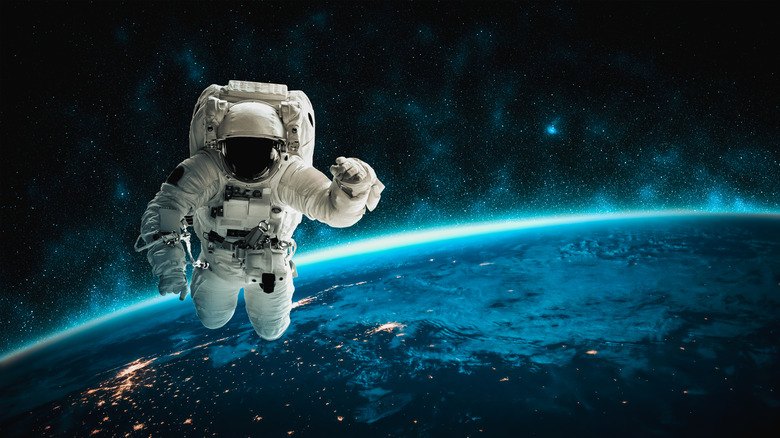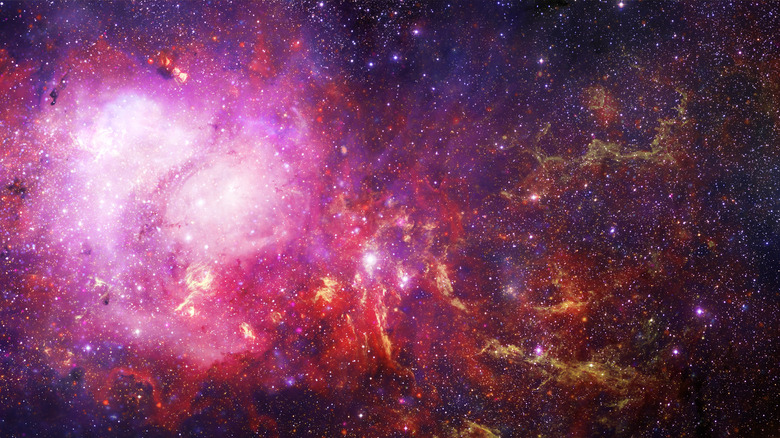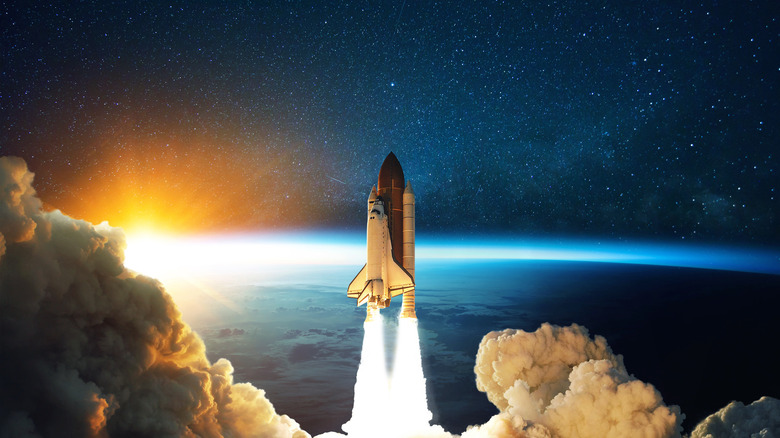NASA's 5 Hazards Of Human Spaceflight Explained


Blue Planet Studio/Shutterstock
Going to space is a perilous task. The deeper you go, the more dangerous it becomes. In order to assess the risk factors of a spaceflight to Mars, something NASA has been looking towards for some time, its Human Research Program developed a list of the top five hazards that humans face during a journey into space. As you can imagine, putting a human meant for the environment of Earth into an atmosphere entirely devoid of his or her necessities can have many pitfalls.
The five hazards that NASA determined for longer spaceflight were radiation, isolation, distance from Earth, gravity, and the hostile, enclosed environments. Each of these can have a massive impact on a human's health, both physiologically and psychologically. For these reasons, astronauts are put through intense training regimens and team-building practices in order to be able to handle these potentialities.
Space radiation

Outer Space/Shutterstock
When underneath Earth's atmosphere, it offers us a level of protection against radiation from space. When you exit Earth's orbit, the radiation you are exposed to increases exponentially. Because of this, astronauts are exposed to lots of space radiation, also known as ionizing radiation. The exact amount is they are exposed to is shocking — anywhere from 50 to 2,000 mSv, or Milli-Sievert, as reported by NASA. This is the same as receiving 150 to 6,000 chest X-rays (per NASA).
Being exposed to such a large amount of radiation has a myriad of negative effects (via CDC). Cancer risk is increased, as is the risk of radiation sickness. It can also have an effect on cognitive and motor functions, and the central nervous system. Research has determined these effects are to be expected from exposure to radiation from galactic cosmic rays and solar particle events. For these reasons, radiation is one of the more harmful hazards of being up in space, per NASA.
Isolation and confinement

Alones/Shutterstock
For astronauts traveling to space, its a given that living quarters are going to be cramped. Further, the only real human contact you have is the small team aboard the ship with you, and you're extremely far away from your home and family, living under very stressful circumstances. Conditions like these can be a potent recipe for cabin fever, impacting astronauts' mental health. This isolation, when compounded by the other stresses that go with embarking on a space mission, can cause unclear thinking, making the potential for mistakes much higher.
There are many ways NASA has worked to combat this. NASA's Human Research Program developed the acronym CONNECT for astronauts to remember during their mission to help them cope with the feeling of isolation. This acronym stands for Community, to realize that what they're doing is important to society; Openness, to have an open-minded attitude towards difficulties; Networking, to encourage interaction with others; Needs, to make sure they account for basic health such as sleeping and eating; Expeditionary Mindset, to have a headstrong attitude towards challenges; Countermeasures, to practice stress-reducing activities; and Training, to remember to practice enhancing their skills.
Furthermore, NASA is conducting research to help try and detect early signs of impaired mental functioning in order to keep space missions running smoothly.
Distance from Earth

Dima Zel/Shutterstock
Being far from Earth is very hazardous if an emergency were to occur. The further you get from home base, the more self-sufficient astronauts are be expected to be. From the International Space Station, it's a short trip down to Earth. On a longer trip, though, getting back wouldn't be so easy, and additional training is required to keep astronauts safe in potential emergencies.
Another big issue with being distant from Earth is the difficulty of resupply. A far journey, like Mars, would call for astronauts to be frugal with the materials they have, as there would be no way to get anything extra from such a far distance from Earth. Because of this, it can make for very tricky situations if anything were to go wrong.
Gravity

Blue Planet Studio/Shutterstock
One of the biggest differences between being on Earth and being on space is gravity. The lack of it in space always needs to be accounted for, as it can have plenty of unforeseen effects. This includes on the bodies of astronauts as well. First, their bodies need to acclimate to the loss of gravity, which can be a jarring experience in and of itself. They'll then need to spend months or years, depending on the mission, in this lessened state of gravity. This can cause problems such as muscle degeneration, loss of bone density, and vision issues, NASA reports.
After spending such a long time in different fields of gravity, they would then need to reacclimate to Earth's gravity. Again, this would be very shocking to the body, and there would be impacts to the astronauts bones, blood vessels, and muscles. Strategies are being developed by NASA to counteract these problems, some of the most long-lasting ones for an astronaut to endure, including artificial gravity.
Hostile and closed environments

Hamara/Shutterstock
Allowing for a group of humans to exist in space takes a lot of resources. For humans, space is extremely hostile, and its pertinent that astronauts maintain their health through the resources available on the ship. Because so many different systems need to be in place in order for humans to survive through a space mission, it's important that they stay running smoothly. If something were to go wrong with these systems, it could be a life or death situation.
One function of life support in space, because of the closed nature of a spaceship, is to monitor air quality. Humans do give off some toxins such as ammonia, and research has found that it can act negatively on the brain and cause impaired memory. Other toxins that need to be rid of on a spaceship include carbon dioxide, formaldehyde, and carbon monoxide.
The environment of space and the stress of space travel can also impact an astronauts immune system, NASA explains, making them more susceptible to disease. This makes life support systems and monitoring even more important, especially in the close confines of a ship.
Read More https://www.travelsaverxl.com/nasas-5-hazards-of-human-spaceflight-explained/?feed_id=3266&_unique_id=630b390555d7c
Comments
Post a Comment